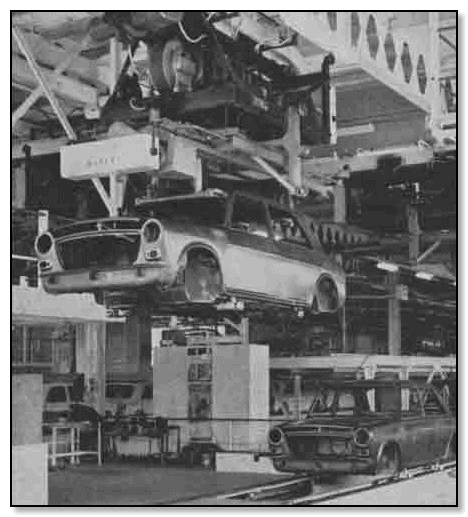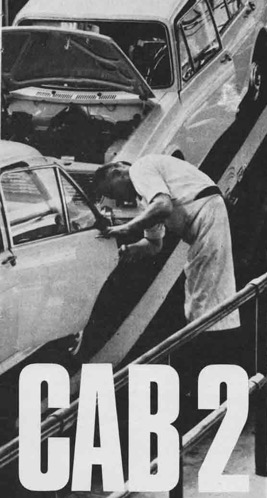CAB 2
CAR ASSEMBLY Building No. 2. is the latest addition to our plant at Longbridge and boasts some of the very latest electronic aids to mass production to assist in the control of its output of Austin 1100s. Initial programming for the week's production comes from a computer, acting on such information as sales forecasts and actual orders. Copies of this production programme are sent to the Production Controller and the Sequence Point Operator, who controls the movement of bodies through the storage area. The Production Controller also receives the production specification (le. standard or de-luxe, right or left-hand drive, body colour, trim colour, etc.) of the cars to be built that week. Then accord-ing to immediate requirements or shortages in the paint plant, he informs the Paint Colour Controller as to the colour required for the next batch of bodies. This information is passed on to the sprayers by means of a tally attached to the first body shell of the new batch. As the painting process takes some 6A hours, the instructions are issued about seven hours in advance. With information from the paint plant and from the various supply departments at his disposal, the Production Controller is able to choose the production specifications for the batch of bodies passing through the paint plant at that particular time. The specification for each car is given on a card, of which there are two copies per vehicle_ These are sent by the Production Controller to the Sequence Point Operator by means of a vacuum-tube communication system. From the information given on the two cards and by taking into account the number of inspected bodies available on the storage conveyor, the operator passes on the relevant information (by means of a Data Sender of Austin design and construction working in conjunction with teleprinters) to all the departments involved. These include trim supply, body-finish marshalling, the engine factory, the engine storage balcony, fascia assembly, wheel and tyre supply, and the Production Controller.

Thus, each department knows what it has to supply and the order in which it is to be despatched. One production specification card is attached to the body whilst the other copy is sent by the vacuum-tube communication system to the body-finish marshalling area. Here it is attached to a trolley, which is to carry the relevant trim, electrical equipment, windows, etc necessary to finish the body. The trolleys are sequenced to arrive at the head of the body finishing conveyor at the same time as the correct body, their specification cards and the cards attached to the body serving as a cross check. At the end of the finishing track the completed body is lifted by means of a four-post sling for transportation to the final assembly track. As there are two finishing tracks and two final assembly tracks, there are two separate dual-rail overhead conveyor systems to do this. The final assembly track may be considered in three parts. On the first section, which is 92 feet in length and moves at lift/min, the sub-frames are prepared for fitting to the body_ On the engine storage balcony, engines in the correct production sequence are mounted in front subframes. Small parts such as the heater connections, speedometer cable, fan and fan belt are then added to the engine. This assembly is lowered to the first section of the final assembly track, where it is located on a jig and joined, on an adjacent jig, by a rear subframe. To the partly assembled front subframe are added the gear change linkage, Hydrolastic displacer units, the suspension linkages, brakes, radiator and hoses. while the rear drum brake assemblies, Hydrolastic units, suspension arms, pitch bars and anti-roll bars arc fitted to the rear subframe. Finally, the rear brakes are adjusted before a crane carries the pair of sub-frames to the Stage One track (131 feet long, moving at 4.8 ft/min). With the exhaust system loosely fitted, everything is ready for the body to be lowered down on to the subframes, and this occurs automatically, when the subframes reach a predetermined point. One of the many operations carried out on the Stage One track k charging the Hydrolastic suspension system. This is done in two parts, Firstly, the system is evacuated to a vacuum pressure of 2131 in Hg before a rust inhibiting, anti-freeze fluid is pumped in to give an initial pressure of 350 Ibl/in2. The second pan of the operation takes place some twenty minutes later, when the pressure is reduced to 205 Ibl/in2., which is the pressure required for normal laden running conditions. By this means, the primary creep of the rubber components in the displacer units is effectively overcome. Both phases of the operation are carried out automatically after the operator has connected the machine to each of the Hydrolastic pipes on the car. The second phase, which takes place on the Stage Two track, is carried out in a similar manner, the surplus fluid returning to an over spill tank for reuse. In addition. on the Stage Two track (which is 264 feet long and moves at 5.1 ft/min, 5 feet above floor level) the clutch and brake systems are bled, the door locks set and the assembled car subjected to a very thorough inspection before being driven off the track and on to a roller test-rig, Here, skilled testers are able to check the engine, transmission, brakes and steering under simulated road conditions. About one in every four cars are then put through the storm booth test, in which the car is subjected to a 45 m.p.h. "wind", with water spraying down on it from all angles. Finally, the car passes down the car-finishing conveyor, and small adjustments are made before the vehicle is polished ready for delivery. Models destined for the export market or storage are given a protective coating of wax, whereas those for immediate delivery on to the home market proceeds direct to Car Despatch and thence, via the comprehensive Distributor network, to the customer. Just as the Austin 1100 has been acclaimed as a tribute to the skill and creative genius of the B.M.C. designers, the success of C.A.B. 2 may be attributed to the brilliance of the Longbridge production engineers. Michael Stewart,

